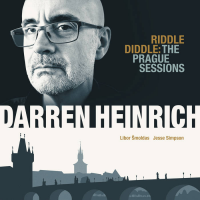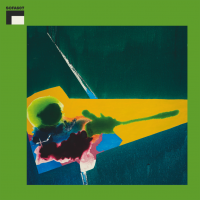Home » Jazz Articles » Album Review » Marius Neset/London Sinfonietta: Snowmelt
Marius Neset/London Sinfonietta: Snowmelt
If Neset was searching for that big sound, the opportunity came closer in 2012 through his collaboration with the twelve-piece Trondheim Jazz Orchestra, a commission by the Molde Jazz Festival 2012 that would produce Lion (ACT Music, 2014), a visceral yet lyrical tour de force. Like Lion, Snowmelt's roots also lie in a commission, this time by the Oslo Sinfonietta. The original fifteen-minute piece for solo saxophone, chamber orchestra and choir premiered in March 2013, but Neset had a bigger vision to realize and continued labouring on Snowmelt through 2015.
A labour of love it has certainly been. Of the suite's eleven segments for jazz quartet and nineteen-piece orchestra, the three main pieces of the original commission-weighing in at just under half the album's fifty-odd minutes—account for some two hundred and thirty nine pages of full orchestral score. It is, without a doubt, Neset's most ambitious work to date. Not surprisingly, the full score's abundant riches do not render themselves completely upon first listening, as Neset clearly subscribes to Gustav Mahler's oft quoted credence that "a symphony must be like the world—it must contain everything."
Mahler is perhaps an obvious musical reference in the sublime, adagio-like passages, and Igor Stravinsky too, seems to guide Neset's pen in places. Frank Zappa, potentially, is also a kindred, guiding spirit. It's a potent mix. Tender yet epic, majestically sweeping and knottily complex in turn, Snowmelt is as challenging—at least initially—as it is rewarding, with Neset weaving dense sonic threads of vibrant colors, only to slowly unravel them and then begin the process all over again. And at heart, for all its orchestral ambition, for all its complexity, Snowmelt, is essentially rhythmic music in essence, with the pendulum swinging fairly constantly between urgent and faint pulses, and befitting a musician trained in Copenhagen's famed Rhythmic Music Conservatory.
To that end, the rhythm section of Anton Eger, Ivo Neame and Petter Eldh is central to the ebb and flow of the music. Following the pastoral chirping of reeds and flutes on "Sirens," Neame's martial rat-a-tat—a repeating motif—is an ominous harbinger of the symphonic tumult that ensues, led by Neset's spiralling soprano saxophone. Eldh, Eger and Neame construct a bridge of rhythmic continuity, short and direct, between "Sirens" and the aptly named "Acrobatics," coming into their own as Neset peels away in a typically searching tenor saxophone solo. Rhythmic function aside, Neset also employs the trio with painterly touches, notably on the adagio passage of "The Storm is Over"; a single note from a triangle, whispering cymbal, sotto voce rumbling mallets and spacious piano notes falling slowly like raindrops -nuances that enrich this achingly lyrical score like gold leaf on a tapestry.
The sheer breadth of compositional elements and the ever-evolving dynamics—heraldic trumpets, pizzicato violin/viola riffs, staccato ensemble motifs, stomping brass rhythms, deliriously fast and intricately layered reed, flute and saxophone passages—make for an absorbing listening experience. Contrasts abound and are bound up together in a sprawling celebratory mosaic, from stormy and shrill to lulling and lyrical, epic and minimalist in turn. From the first unaccompanied soprano saxophone notes of "Prologue," in fact, Neset weds melody and dissonance, tenderness and abrasiveness, the one flowing seamlessly into the other. In these two minutes Neset lays down a marker for the overarching juxtapositions to follow.
There are multiple highlights over the course of just over fifty minutes, but it's hard to beat the beauty of the final twenty five minutes that encompass the episodic "The Storm is Over," the tenor saxophone monologue "Introduction to Snowmelt" and the uplifting "Snowmelt"—a wonderful embrace between contemporary classical and jazz idioms.
With Snowmelt, Neset has arguably established himself—at just thirty two years of age—as one of the most significant and adventurous of modern composers and performers. Masterly and inspired, Snowmelt is a major contemporary work that will no doubt be studied, analysed and performed for years to come
Track Listing
Prologue; Arches of Nature: Sirens; Arches of Nature: Acrobatics; Arches of Nature; Circles; Arches of Nature: Caves; Arches of Nature: Paradise; Arches of Nature; Rainbows; Arches of Nature: Pyramiden; The Storm is Over; Introduction to Snowmelt; Snowmelt.
Personnel
Marius Neset
saxophoneMarius Neset: tenor and soprano saxophones; Ivo Neame: piano; Petter Eldh: bass; Anton Eger: drums. London Sinfonietta conducted by Geoffrey Patterson; Karen Jones: flute, piccolo; Gareth Hulse: oboe; Michael Whight: clarinet, bass clarinet; John Orford: bassoon; Michael Thompson: horn; Torbjørn Hultmark: trumpet; Byron Fulcher: trombone; Jonathon Morton: violin (principal 1st); Miranda Fulleylove: violin; Elizabeth Wexler: violin; Joan Atherton: violin (principal 2nd); Hilaryjane Parker: violin; Charlotte Reid: violin; Roger Chase: viola; Zoe Matthews: viola; Richard Waters: viola; Tim Gill: cello; Adrian Bradbury: cello; Markus van Horn: contrabass.
Album information
Title: Snowmelt | Year Released: 2017 | Record Label: ACT Music
Tags
PREVIOUS / NEXT
Marius Neset Concerts
Support All About Jazz
 All About Jazz has been a pillar of jazz since 1995, championing it as an art form and, more importantly, supporting the musicians who make it. Our enduring commitment has made "AAJ" one of the most culturally important websites of its kind, read by hundreds of thousands of fans, musicians and industry figures every month.
All About Jazz has been a pillar of jazz since 1995, championing it as an art form and, more importantly, supporting the musicians who make it. Our enduring commitment has made "AAJ" one of the most culturally important websites of its kind, read by hundreds of thousands of fans, musicians and industry figures every month.




















